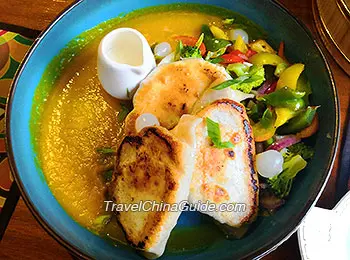How Much do You Know about Mongolian Cuisine?
The Mongols have lived a very nomadic life for centuries. The vast barren lands and the life with the herds contributed to a very unique gastronomic tradition in the country. By large, you will find Mongolian cuisine is based on milk and meat. It is not very difficult to understand that the links to the country's nomadic tradition influenced these kind of food habits. Russia, China and many other Central Asian countries have influenced the culinary tradition of Mongolia. From Tibetan style dumplings to boiled mutton, Mongolia thrives on a very different type of food style. Often there is a saying in the country that 'meat is for men and grass for animals'.
 |
| Mongolian Cuisine |
Traditional Cooking Way
Hierarchy of Food
In 1991, the Russians pulled the plug from the country and the economy went into a huge dip. That was the first time when the country experienced hunger and the staple meat, flour and milk helped the people survive the crisis. Generally, the Mongolians turn towards a diet that is rich in minerals and proteins. There is less dependence on seasonal vegetables and fruits but it is not just the meat that they eat. Mongolians also survive on barley, cereal and some natural fruits that are native to the country's vegetation. Given the necessity, Mongolians have created ingenious ways to drink milk from all the five main domestic animals - cattle, sheep, camels, goats and horses. In 1997, there was a substantial increase in the quantity as well as diversity of imported food in Mongolia. Since then, the Soviet-style market stalls are now competing against the Western-style supermarkets.
Food Habits & Special Dishes
Mongolian Barbecue or Khorkhog is widely seen in all across the country. It is generally made with mutton and in an open fire. Some flavors and vegetables are made to make the stew and is left to blend for many hours. You can enjoy this hot Barbecue while sitting inside a ger and experiencing a firsthand nomadic culture. Talking of Barbecue, Boodog is another famous Mongolian cuisine that is made from young goat or marmot. It also uses a variety of spices and vegetables and is a typical example of utilitarian nomadic lifestyle.
Buzz bansh Khuushuur are some of the famous dumplings that you will find in almost all Mongolian dinner tables. They are although distinctly different from the Chinese dim sum. It is basically a version of Mongolian fast foods.
 Read more about Top 4 Mongolian Street Food Mongolian Hotpot
Read more about Top 4 Mongolian Street Food Mongolian Hotpot
Eating Habits & Customs
Generally, Mongolians start with a light breakfast and have a lunch between 1 to 2 p.m. and dinner ends by 8:00 p.m. Sundays have a typically elaborate meal as compared to the other days. In a ger, the most typical Mongolian diet will include noodle soup, cabbage salad, rice, meat stew, beer and biscuits. If you look at a glance at Mongolia's cuisine, it might appear that it is the world's least vegetarian friendly place. The food that stops the chart include beef, mutton and goat. Although you can find potatoes to some extent, and vegetables like cabbage carrots and onion are also found, they are not the first food that you will see. Even though the country is predominantly a follower of Buddhism, nomadic herding has been at the core of these people's economy and culture, which is why they cannot stay away from their products and meat. Also most of the vegetables are imported from China which makes it a bit pricier than the rest.
The eating customs of the people is also simple. They do not use chopsticks, instead use a fork, spoon or even just their hands. Sometimes, the boiled meat is passed on a communal bowl along with a knife and people just cut a piece and pass on to the next one. The most popular choice of the meat piece is the one that have the most fat.
 Read more about Mongolian Desserts
Read more about Mongolian Desserts
Traditional Drinks & Beverage
When you enter a ger, you will be offered with tea with milk and salt in a typical Mongolian bowl along with a plate of various cheese breads and cookies. You should accept it with your right hand and is expected to take at least one small sip from what is served to you. Anything otherwise is considered extremely impolite.
- Last updated on Aug. 13, 2025 by Gabby Li -